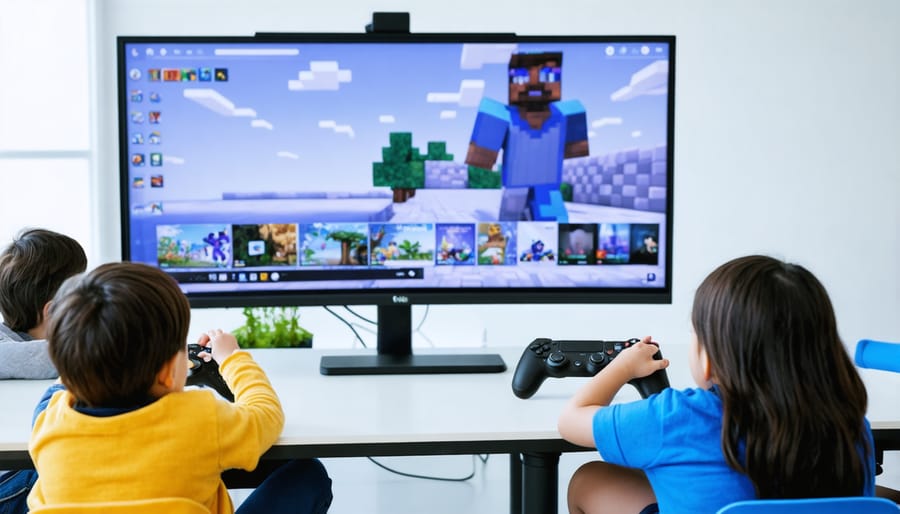Game-Based E-Learning: How Teachers Are Transforming Higher Education
E-learning has revolutionized how we think about education, transforming traditional classrooms into dynamic digital spaces where learning knows no boundaries. Gone are the days when education was confined to brick-and-mortar buildings and fixed schedules. Today, students and educators harness the power of technology to create flexible, personalized learning experiences that adapt to individual needs and learning styles.
Picture a world where a medical student in rural India attends virtual lectures from top universities, while a working professional in New York completes their MBA during lunch breaks. That’s the transformative power of e-learning – breaking down geographical barriers and democratizing education for millions worldwide.
At its core, e-learning combines digital technology with educational principles to deliver engaging, interactive content through computers, tablets, and smartphones. Whether it’s video lectures, interactive quizzes, virtual labs, or collaborative online projects, e-learning tools are reshaping how we teach, learn, and assess knowledge in the digital age.
Modern E-Learning in Higher Education
Digital Tools Reshaping College Classrooms
Today’s college classrooms are being transformed by innovative digital tools in education. Learning management systems (LMS) like Canvas and Blackboard have become virtual headquarters where students access course materials, submit assignments, and engage in online discussions. Interactive presentation tools such as Mentimeter and Kahoot! turn passive lectures into dynamic learning experiences, while virtual labs and simulations allow students to conduct experiments safely from anywhere.
Cloud-based collaboration platforms like Google Workspace for Education enable real-time teamwork on projects, breaking down physical barriers to group work. Video conferencing tools have evolved beyond simple remote lectures, now featuring breakout rooms, virtual whiteboards, and instant polling to maintain student engagement. Digital assessment tools provide immediate feedback and help instructors track student progress more effectively.
These tools aren’t just making learning more convenient – they’re creating new possibilities for personalized education, allowing students to learn at their own pace and in their preferred style.

Benefits of Interactive Learning Platforms
Interactive learning platforms have revolutionized how we teach and learn by making education more engaging and accessible. These platforms allow students to learn at their own pace while receiving instant feedback on their progress. Teachers can easily track student performance, identify areas where learners need additional support, and adjust their teaching strategies accordingly.
One of the biggest advantages is the ability to personalize learning experiences. Students can choose paths that match their learning style, whether they prefer visual content, hands-on activities, or traditional text-based materials. This flexibility helps maintain student interest and improves information retention.
The collaborative features of these platforms encourage peer-to-peer learning and discussion, creating a more dynamic learning environment. Students can work together on projects, share ideas, and learn from each other’s perspectives, all within a structured digital space.
Additionally, interactive platforms often include gamification elements that make learning fun and motivating. Points, badges, and achievement systems tap into students’ natural competitive spirit while encouraging consistent engagement with the material. This approach helps transform potentially challenging subjects into enjoyable learning experiences.
Game-Based Learning: The New Educational Frontier
Types of Educational Games in College Settings
Educational games in college settings come in various exciting formats, each designed to make learning more engaging and effective. Simulation games are particularly popular, allowing students to practice real-world scenarios in fields like business management, medical procedures, and engineering design. These games provide a safe space for trial and error without real-world consequences.
Quiz-based games add a competitive element to learning, perfect for reviewing complex topics or preparing for exams. Many of these games feature leaderboards and point systems that motivate students to improve their performance and retain information better.
Role-playing games are excellent for developing soft skills and understanding different perspectives. In subjects like psychology, sociology, or business ethics, students can step into various roles to better grasp complex interpersonal dynamics and decision-making processes.
Problem-solving games challenge students to think critically and apply theoretical knowledge to practical situations. These might include virtual labs for science courses or case study games for business students.
Strategy games help develop planning and analytical skills, particularly useful in subjects like economics, political science, and urban planning. Students learn to manage resources, make strategic decisions, and understand complex systems through gameplay.
Virtual reality (VR) games are gaining popularity, especially in fields requiring spatial understanding or hands-on practice, like architecture, anatomy, or archaeological studies. These immersive experiences make abstract concepts tangible and memorable.

Student Engagement Through Gaming Elements
Gaming elements in e-learning have revolutionized how students interact with educational content, making learning more engaging and fun. When implemented thoughtfully, game mechanics can increase student engagement and motivation in ways traditional teaching methods often struggle to achieve.
Think of features like points, badges, and leaderboards – they tap into students’ natural competitive spirit and desire for achievement. When students see their progress tracked visually or earn rewards for completing challenges, they’re more likely to stay motivated and push themselves further.
But it’s not just about competition! Game-based learning also incorporates storytelling, character progression, and choice-based learning paths. Students become active participants in their learning journey, making decisions that affect their outcomes and experiencing natural consequences in a safe, educational environment.
Some effective gaming elements you can easily implement include:
– Progress bars showing completion rates
– Achievement badges for mastering concepts
– Experience points for completing assignments
– Level-up systems for advancing through topics
– Team challenges for collaborative learning
These features work because they provide immediate feedback, create clear goals, and make the learning process more enjoyable. Students feel a sense of accomplishment and ownership over their learning, which naturally leads to better retention and participation.
Implementing Game-Based E-Learning Successfully

Choosing the Right Game Format
Selecting the right game format for your subject matter is crucial for effective e-learning. For math-focused content, puzzle games and number-based challenges work wonderfully, helping students practice calculations while having fun. Language arts thrive with word games, storytelling adventures, and interactive vocabulary challenges that keep students engaged.
Science subjects benefit from simulation games and virtual labs, where students can experiment safely and see cause-and-effect relationships in action. For history and social studies, role-playing games and strategy-based scenarios help bring historical events to life and develop critical thinking skills.
Consider your students’ age group and skill level when choosing game formats. Younger learners respond well to colorful, simple games with immediate feedback, while older students appreciate more complex, strategy-based challenges. Remember to match the game’s difficulty to your learning objectives – it should be challenging enough to maintain interest but not so difficult that it frustrates students.
Start small with simple game formats and gradually introduce more complex ones as your students become comfortable with game-based learning. This approach helps build confidence while maintaining engagement throughout the learning process.
Creating Engaging Game Content
Creating engaging game content starts with understanding your students’ interests and learning goals. Keep your games simple but challenging enough to maintain interest. Start by choosing topics that naturally lend themselves to gamification – like vocabulary matches, historical timelines, or math problem-solving challenges.
Include clear objectives and reward systems that motivate students without overwhelming them. Consider incorporating progressive difficulty levels that allow students to build confidence while mastering new concepts. Remember to add interactive elements like clickable objects, drag-and-drop features, or timed challenges to keep students actively engaged.
Make your games visually appealing with bright colors and age-appropriate graphics, but avoid cluttered designs that might distract from learning objectives. Include feedback mechanisms that celebrate success and gently guide students when they make mistakes. Consider adding storytelling elements to create emotional connections with the material.
Customize your games to fit different learning styles by including both visual and audio elements. Don’t forget to build in opportunities for collaboration when possible – team-based games can enhance both learning and social skills while making the experience more enjoyable.
Measuring Learning Outcomes
Tracking student progress in e-learning goes beyond traditional test scores. The beauty of digital learning platforms is that they offer multiple ways to measure how well your students are catching on. You can easily monitor engagement levels through time spent on activities, track completion rates of assignments, and see real-time progress as students work through different learning modules.
Many e-learning platforms come with built-in analytics that show you exactly where students excel and where they might need extra help. You can look at metrics like participation in online discussions, success rates in interactive quizzes, and even how students collaborate in virtual group projects.
The best part? These tools let you customize assessments to match your teaching style. You might use digital portfolios, interactive presentations, or even student-created games to evaluate learning. Plus, automated feedback systems help students understand their progress right away, while giving you valuable insights into class-wide learning trends.
Remember to gather student feedback too – their experience with the platform is just as important as their performance metrics!
Game-based e-learning has revolutionized the way we teach and learn, making education more engaging and effective than ever before. As we’ve seen, incorporating games into your teaching toolkit can boost student motivation, improve retention, and create a more dynamic learning environment that speaks to today’s tech-savvy learners.
Looking ahead, the future of game-based e-learning is incredibly promising. We’re seeing rapid advances in technology that will bring even more exciting possibilities to your classroom. Virtual reality, artificial intelligence, and adaptive learning systems are already starting to enhance the gaming experience, making it more personalized and responsive to each student’s needs.
The best part? You don’t need to be a tech wizard to get started! With the growing availability of user-friendly platforms and ready-to-use educational games, implementing these tools in your classroom is becoming easier every day. Whether you’re teaching math, science, language arts, or any other subject, there’s likely a game-based solution that can help bring your lessons to life.
Remember, the goal isn’t to replace traditional teaching methods but to enhance them. By combining game-based learning with your existing teaching strategies, you’re creating a more comprehensive and engaging learning experience that prepares students for success in our increasingly digital world.
Start small, experiment with different games, and watch as your students become more enthusiastic about learning. The future of education is here, and it’s more fun than we ever imagined!


